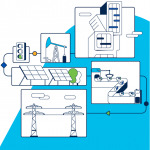Water is one of our most precious resources. Yet every year, we lose more than 126 million cubic meters globally to leaks, poor metering and theft. Beyond that is the energy wasted moving water that never gets used. It adds up to staggering economic – and environmental – costs.
It also presents one of the most compelling opportunities to use industrial IoT solutions.
Water utilities can use IoT to address two fundamental aspects of water management: maintaining the physical infrastructure and addressing water safety and sustainability. With IoT sensors throughout a water utility’s infrastructure, it becomes possible to:
- measure water levels in real time and gather data for longer-term consumption analysis
- proactively detect leaks in the pipes
- monitor health and safety metrics, including levels of chemicals and contaminants
- plan for future infrastructure requirements and consumption
In many ways, these uses mirror what’s possible in manufacturing. But while factory floors are condensed environments – with all assets located in a confined area – water utilities operate highly distributed environments. Reservoirs, pipes, pumps and other assets are spread across a massive physical footprint. Such environments introduce some unique challenges.
One of the most pressing is cost. Capturing data across a massive infrastructure – and moving it to the enterprise and/or cloud – is a heavy lift. That’s especially true when considering the criticality of timely transmission and analysis of water data. Any delay can contribute to continued losses.
So, how can water utilities support the network and compute load that’s required for effective IoT solutions without overloading the cost structure?
The answer is to embed intelligence at the point of collection. Rather than having to capture and then move data, utilities can analyze it and provide actionable insights at the network edge. Utilities could establish clear policies to trigger appropriate responses – for example, to shut off a valve when a reservoir level falls below a certain threshold or to alert when flow capacity is off, suggesting the presence of a leakage that should be addressed. To better understand what are the important decisions that make up a long lasting Edge Computing infrastructure can be found here.
A well-designed industrial IoT network can deliver around-the-clock, in-depth insights across tens of thousands of miles of water infrastructure. And it can do so affordably with edge intelligence. These capabilities are invaluable not only to well-established utilities looking to “replace the pipe” but also in emerging economies that are working to forecast future demand.
Speaking of the future, McKinsey has predicted that by 2030, global demand for water will outpace viable resources by 40 percent. Now is the time to take decisive action to improve how we manage this finite natural resource. There has never been a better time to deploy an intelligent-rich water network that can be simple to deploy, manage and report while meeting the needs of customers, operational staff and IT services.
Learn more about Cisco Edge Intelligence and our work with water utilities around the globe. To find out more about my plans at Cisco IoT and why I’m excited about the prospect of IoT, go here.

CONNECT WITH US